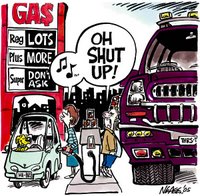 There are a lot of things wrong with last Monday's (5/8) essay by AEI's Kenneth P. Green on what to do about high gas prices -- such as his call for a permanent lifting of boutique fuel requirements instead of calling for homogeneously high standards -- but he prejudices the whole thing right off the bat when he tells the public to stop worrying, things aren't that bad [emphasis mine]:
There are a lot of things wrong with last Monday's (5/8) essay by AEI's Kenneth P. Green on what to do about high gas prices -- such as his call for a permanent lifting of boutique fuel requirements instead of calling for homogeneously high standards -- but he prejudices the whole thing right off the bat when he tells the public to stop worrying, things aren't that bad [emphasis mine]:Once again, high gasoline and oil prices are in the news. As of this writing, the national average gasoline price per gallon ($2.90 on April 23) is approaching a record high of $3.21 per gallon set in 1981 (adjusted for inflation). Oil futures are currently running at about $72.50 per barrel, considerably below the record high of $86.99 per barrel, also set in 1981. The public is upset, and politicians are scrambling to find ways to reduce the pain of high prices, or failing that, to publicly shoot the messenger by investigating, penalizing, or punitively taxing oil companies.While he's correct that prices still haven't reached their inflation-adjusted 1981 records, he's disingenuous about today's very bullish market's very real effects. Two decades of low gas prices have led to a mass urbanite exodus into distant suburbs and neo-urban areas characterized by minimal, if present, manufacturing and commercial sectors. Relatively cheap money, and the nearly zero cost of driving long-distances have made it possible for large sectors of Americans to abandon proximity for the cheap and spacious comfort of the "exurbs."
I remember as a teenager in LA being impressed by the fact that people were willing to commute over an hour each way to downtown LA to live in cheap housing in Lancaster, the Palm Desert, or even the far reaches of Riverside County. Today, given the skyrocketing price of oil, I'm impressed that they will still live that far away.
It's true that the cost of gas is 10% less than it was in 1981, but the true cost is revealed only if we factor in the additional distance we are willing to travel. Kevin Naughton, in the May 1, 2006, edition of Newsweek notes [emphasis mine]:
[M]ore people than ever are willing to trade time in their car for the American Dream: big house, big yard. Nearly 10 million people now drive more than an hour to work, up 50 percent from 1990. The average commute today is 25 minutes, up 18 percent from two decades ago. What drives us to drive so far? Many are doing what California real-estate agents call "driving 'til you qualify." New-home prices have nearly tripled in the past 20 years and now average almost $300,000, according to the National Association of Home Builders. In places like southern California, each exit along the interstate saves you tens of thousands of dollars. That's why Chris Neelley, 43, lives in Lancaster, Calif., and drives 80 miles to L.A. every day. For $400,000 last year, he moved his family of five into a 3,000-square-foot home, twice the size of the place they used to have closer to the city.For a very large number of Americans, gas is now more expensive than ever (the 18% increase in commuting time more than offsets the 10% still to go to match 1981's inflation adjusted gas prices). Cheap oil created these distance pseudo-metropolises. Expensive oil may destroy them. Wake up exurban Bush voters! Violence in Nigeria, the Iraq War, and our President's saber-rattling in Iran are kicking your @$$.
(Cartoon by Steve Nease, 2005, from Daryl Cagle's Professional Cartoonists Index)
No comments:
Post a Comment